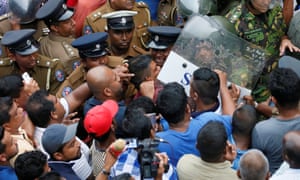The Lankan Crisis- All You Need To Know
On October 26, the President of Sri Lanka, Maithripala Sirisena had sacked the Sri Lankan Prime Minister Ranil Wickramasinghe and had appointed former President, Mahinda Rajapaksa with immediate effect. This came as a shocker for all the Sri Lankans and caused a widespread protest and riots. Sirisena was known to be a gentle person and little did they know that he was a 'wolf disguised in a sheep's clothing'.
The fact to be noted is that the nation’s President and Prime Minister come from traditionally
opposing parties that formed a surprise coalition in 2015 to oust the
then-president Mahinda Rajapaksa, who many feared was becoming too
powerful. In the past two years, this ruling coalition has started to fall
apart. It is dysfunctional and unpopular with the Sri Lankan public.
Since at least February this year, president Maithripala Sirisena has
been searching for ways to remove the prime minister, Ranil
Wickremasinghe. On October 26th, he found one: suddenly declaring he was firing
Wickremasinghe and replacing him with Rajapaksa – the same man he had
joined forces with Wickremasinghe in 2015 to defeat.
Ranil Wickramasinghe challenged Sirisena that he will prove his majority in the Parliament. But Sirisena, in order to avoid his defeat, tried to dissolve the Parliament. The Speaker, Karu Jayasuriya, termed the dissolution order as 'illegal' and moved the issue to the apex court of the country. It took several weeks for the court to process a final verdict. Pro- Wickramasinghe and Pro- Rajapaksa supporters had a series of clashes and riots. The island nation is still recovering from a brutal civil war that ended in 2009 and Sri Lanka prides itself on being one of Asia’s oldest democracies. The past seven weeks have posed a crucial test for its institutions, which have proven more resilient than many experts expected.
The court and the lawmakers had been opposing Sirisena's decision to sack Wickramasinghe and replace him with Rajapaksa, which led to Sirisena trying to dissolve the Parliament. However, there was a remarkable conclusion to the power grab by Sirisena. The Members of Parliament had voted several times, in which Wickramasinghe emerged as the person with the majority. This eventually led to Sirisena reappointing Wickramasinghe as the Prime Minister of Sri Lanka.
Now, why should the Indians be bothered about this political crisis? According to my observations, Rajapaksa is more inclined towards the Chinese and has a bit of hatred towards Indians whereas Wickramasinghe, on the other hand, was more inclined towards the Indians. Rajapaksa's inclination towards the Chinese can be seen from the fact that the Hambantota Port being given to the Chinese on lease for ninety-nine years. It would be really tough for India if Rajapaksa became the Prime Minister and the bilateral ties between India and Sri Lanka would be disturbed. Wickramasinghe's return to power is a huge sigh for the Indians.
| Maithripala Sirisena |
Ranil Wickramasinghe challenged Sirisena that he will prove his majority in the Parliament. But Sirisena, in order to avoid his defeat, tried to dissolve the Parliament. The Speaker, Karu Jayasuriya, termed the dissolution order as 'illegal' and moved the issue to the apex court of the country. It took several weeks for the court to process a final verdict. Pro- Wickramasinghe and Pro- Rajapaksa supporters had a series of clashes and riots. The island nation is still recovering from a brutal civil war that ended in 2009 and Sri Lanka prides itself on being one of Asia’s oldest democracies. The past seven weeks have posed a crucial test for its institutions, which have proven more resilient than many experts expected.
 | ||
| The clash between Rajapaksa and Wickramasinghe supporters |
The court and the lawmakers had been opposing Sirisena's decision to sack Wickramasinghe and replace him with Rajapaksa, which led to Sirisena trying to dissolve the Parliament. However, there was a remarkable conclusion to the power grab by Sirisena. The Members of Parliament had voted several times, in which Wickramasinghe emerged as the person with the majority. This eventually led to Sirisena reappointing Wickramasinghe as the Prime Minister of Sri Lanka.
Now, why should the Indians be bothered about this political crisis? According to my observations, Rajapaksa is more inclined towards the Chinese and has a bit of hatred towards Indians whereas Wickramasinghe, on the other hand, was more inclined towards the Indians. Rajapaksa's inclination towards the Chinese can be seen from the fact that the Hambantota Port being given to the Chinese on lease for ninety-nine years. It would be really tough for India if Rajapaksa became the Prime Minister and the bilateral ties between India and Sri Lanka would be disturbed. Wickramasinghe's return to power is a huge sigh for the Indians.
Comments
Post a Comment
Let me know what you think...